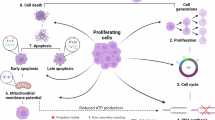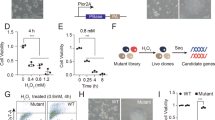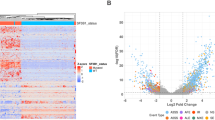Abstract
We carried out gain-of-function mutagenesis screening and identified a mutant in which GAL4 induction led to both hyperplasia and apoptosis. The gene involved was identified as stonewall (stwl), a myb-related gene involved in germ cell proliferation and differentiation during oogenesis. As observed with dmyb, the ectopic expression of stwlUY823 inhibited endoreplication in salivary glands. We also found that stwlUY823 overexpression, like overexpression of the wild-type gene, activated G1/S transition and apoptosis. The apoptosis triggered by stwlUY823 expression is correlated to induction of the proapoptotic gene reaper. Finally, the death of flies induced by ectopic stwlUY823 expression is efficiently prevented in vivo by triggering cell death in stwlUY823-expressing cells. Our results suggest that stwlUY823 kills flies by causing inappropriate cell cycle entry, and that triggering the death of these overproliferating cells or slowing their proliferation restores viability.
Similar content being viewed by others
Log in or create a free account to read this content
Gain free access to this article, as well as selected content from this journal and more on nature.com
or
Abbreviations
- AO:
-
acridine orange
- Brat gene:
-
brain tumor gene
- BrdU:
-
bromodeoxyuridine
- CDS:
-
coding DNA sequence
- CyO:
-
curly of Oster
- da :
-
daughterless
- Dpp :
-
decapentaplegic
- en :
-
engrailed
- fkh :
-
fork head
- GFP:
-
green fluorescent protein
- gmr:
-
glass-mediated response
- GUS:
-
gmr UAS
- hid :
-
head involution defective
- Hs:
-
heat shock
- hsp70:
-
heat-shock protein 70
- ORF:
-
open reading frame
- PBS:
-
phosphate-buffered saline
- PCD:
-
programmed cell death
- rpr :
-
reaper
- Sev :
-
sevenless
- stwl :
-
stonewall
- UAS:
-
upstream activating sequences
- vg :
-
vestigial
- ywc:
-
yellow white C
- ZNC:
-
zone of nonproliferating cells
References
Edgar BA and Orr-Weaver TL (2001) Endoreplication cell cycles: more for less. Cell 105: 297–306
Hipfner DR and Cohen SM (2004) Connecting proliferation and apoptosis in development and disease. Nat. Rev. Mol. Cell Biol. 5: 805–815
Abrams JM and White MA (2004) Coordination of cell death and the cell cycle: linking proliferation to death through private and communal couplers. Curr. Opin. Cell Biol. 16: 634–638
Gaumer S, Guénal I, Brun S, Théodore L and Mignotte B (2000) Bcl-2 and Bax mammalian regulators of apoptosis are functional in Drosophila. Cell Death Differ. 7: 804–814
Brun S, Rincheval V, Gaumer S, Mignotte B and Guénal I (2002) rpr and bax initiate two different apoptotic pathways affecting mitochondria and antagonized by bcl-2 in Drosophila. Oncogene 21: 6458–6470
Hay BA, Huh JR and Guo M (2004) The genetics of cell death: approaches, insights and opportunities in Drosophila. Nat. Rev. Genet. 5: 911–922
Mignotte B, Colin J, Brun S and Guénal I (2005) Apoptosis: the fly point of view. In Apoptosis, Scovassi AI (ed) (Kerala, India: Research Signpost) pp. 169–186 (ISBN: 81-308-0021-7)
Brodsky MH, Nordstrom W, Tsang G, Kwan E, Rubin GM and Abrams JM (2000) Drosophila p53 binds a damage response element at the reaper locus. Cell 101: 103–113
Sogame N, Kim M and Abrams JM (2003) Drosophila p53 preserves genomic stability by regulating cell death. Proc. Natl. Acad. Sci. USA 100: 4696–46701
Morey M, Corominas M and Serras F (2003) DIAP1 suppresses ROS-induced apoptosis caused by impairment of the selD/sps1 homolog in Drosophila. J. Cell Sci. 116: 4597–4604
Schumacher B, Hofmann K, Boulton S and Gartner A (2001) The C. elegans homolog of the p53 tumor suppressor is required for DNA damage-induced apoptosis. Curr. Biol. 11: 1722–1727
Prober DA and Edgar BA (2000) Ras1 promotes cellular growth in the Drosophila wing. Cell 100: 435–446
Bergmann A, Agapite J, McCall K and Steller H (1998) The Drosophila gene hid is a direct molecular target of Ras-dependent survival signaling. Cell 95: 331–341
Baehrecke EH (2003) miRNAs: micro managers of programmed cell death. Curr. Biol. 13: R473–R475
Du W, Xie JE and Dyson N (1996) Ectopic expression of dE2F and dDP induces cell proliferation and death in the Drosophila eye. EMBO J. 15: 3684–3692
Pedraza LG, Stewart RA, Li DM and Xu T (2004) Drosophila Src-family kinases function with Csk to regulate cell proliferation and apoptosis. Oncogene 23: 4754–4762
Hipfner DR and Cohen SM (2003) The Drosophila sterile-20 kinase slik controls cell proliferation and apoptosis during imaginal disc development. PLoS Biol. 1: E35. (Epub 2003 Nov 2017)
Fitzpatrick CA, Sharkov NV, Ramsay G and Katzen AL (2002) Drosophila myb exerts opposing effects on S phase, promoting proliferation and suppressing endoreduplication. Development 129: 4497–4507
Secombe J, Pierce SB and Eisenman RN (2004) Myc: a weapon of mass destruction. Cell 117: 153–156
Sutcliffe JE, Korenjak M and Brehm A (2003) Tumour suppressors – a fly's perspective. Eur. J. Cancer 39: 1355–1362
Harbour JW and Dean DC (2000) Rb function in cell-cycle regulation and apoptosis. Nat. Cell Biol. 2: E65–E67
Knudsen KE, Weber E, Arden KC, Cavenee WK, Feramisco JR and Knudsen ES (1999) The retinoblastoma tumor suppressor inhibits cellular proliferation through two distinct mechanisms: inhibition of cell cycle progression and induction of cell death. Oncogene 18: 5239–5245
Lemaire C, Godefroy N, Costina-Parvu I, Rincheval V, Renaud F, Trotot P, Bouleau S, Mignotte B and Vayssicre JL (2005) Caspase-9 can antagonize p53-induced apoptosis by generating a p76(Rb) truncated form of Rb. Oncogene 24: 3297–3308
Hsieh JK, Chan FS, O'Connor DJ, Mittnacht S, Zhong S and Lu X (1999) RB regulates the stability and the apoptotic function of p53 via MDM2. Mol. Cell. 3: 181–193
Monnier V, Girardot F, Cheret C, Andres O and Tricoire H (2002) Modulation of oxidative stress resistance in Drosophila melanogaster by gene overexpression. Genesis 34: 76–79
Clark KA and McKearin DM (1996) The Drosophila stonewall gene encodes a putative transcription factor essential for germ cell development. Development 122: 937–950
Akiyama T (2002) Mutations of stonewall disrupt the maintenance of female germline stem cells in Drosophila melanogaster. Dev. Growth Differ. 44: 97–102
Blanchardon E, Grima B, Klarsfeld A, Chelot E, Hardin PE, Preat T and Rouyer F (2001) Defining the role of Drosophila lateral neurons in the control of circadian rhythms in motor activity and eclosion by targeted genetic ablation and PERIOD protein overexpression. Eur. J. Neurosci. 13: 871–888
Baehrecke EH (2002) How death shapes life during development. Nat. Rev. Mol. Cell Biol. 3: 779–787
Nordstrom W, Chen P, Steller H and Abrams JM (1996) Activation of the reaper gene during ectopic cell killing in Drosophila. Dev. Biol. 180: 213–226
Toba G, Ohsako T, Miyata N, Ohtsuka T, Seong KH and Aigaki T (1999) The gene search system. A method for efficient detection and rapid molecular identification of genes in Drosophila melanogaster. Genetics 151: 725–737
de Vries HI, Brunsting JF, Lemstra W, Kampinga HH and Sibon OCM (2003) Identification of stonewall as a novel Drosophila gene involved in DNA damage response. In 43rd Annual Drosophila Research Conference (Chicago: The Genetics Society of America)
Zhou L, Schnitzler A, Agapite J, Schwartz LM, Steller H and Nambu JR (1997) Cooperative functions of the reaper and head involution defective genes in the programmed cell death of Drosophila central nervous system midline cells. Proc. Natl. Acad. Sci. USA 94: 5131–5136
Wing JP, Zhou L, Schwartz LM and Nambu JR (1998) Distinct cell killing properties of the Drosophila reaper, head involution defective, and grim genes. Cell Death Differ. 5: 930–939
Srinivasula SM, Datta P, Kobayashi M, Wu JW, Fujioka M, Hegde R, Zhang Z, Mukattash R, Fernandes-Alnemri T, Shi Y, Jaynes JB and Alnemri ES (2002) sickle, a novel Drosophila death gene in the reaper/hid/grim region, encodes an IAP-inhibitory protein. Curr. Biol. 12: 125–130
Quinn LM, Dorstyn L, Mills K, Colussi PA, Chen P, Coombe M, Abrams J, Kumar S and Richardson H (2000) An essential role for the caspase dronc in developmentally programmed cell death in Drosophila. J. Biol. Chem. 275: 40416–40424
Vidal S, Kush RS, Leulier F, Tzou P, Nakamura M and Lemaitre B (2001) Mutations in the Drosophila dTAK1 gene reveal a conserved function for MAPKKKs in the control of rel/NK-kB dependent innate immune responses. Genes Dev. 15: 1900–1912
Du W, Vidal M, Xie JE and Dyson N (1996) RBF, a novel RB-related gene that regulates E2F activity and interacts with cyclin E in Drosophila. Genes Dev. 10: 1206–1218
Lane ME, Sauer K, Wallace K, Jan YN, Lehner CF and Vaessin H (1996) Dacapo, a cyclin-dependent kinase inhibitor, stops cell proliferation during Drosophila development. Cell 87: 1225–1235
Zhou B, Bagri A and Beckendorf SK (2001) Salivary gland determination in Drosophila: a salivary-specific, fork head enhancer integrates spatial pattern and allows fork head autoregulation. Dev. Biol. 237: 54–67
Acknowledgements
We thank E Blanchardon for drawing our attention to the UY823 line, F Leulier for providing us with the UAS-dreddδ line, D McKearin, who generously provided us with the stwlΔ95 and the hsp70-stwl mutant strains, the P{w+, minigene stwl} line and the vector containing the stwl cDNA, S Beckendorf, who provided us with the fkh-GAL4 strain, and the Bloomington Drosophila Stock Center for fly stocks. The GS3129 line was a gift from T Aigaki. We also thank I Séminet for performing some of the experiments described in this paper, P Gandille for technical assistance with confocal microscopy, S Gaumer and C Stenbak for critical reading of the manuscript, and J Sappa (from A Edelman & Associates) for English rereading. This work was supported in part by grants from the Association pour la Recherche Contre le Cancer (#3367) and the Ligue Nationale Contre le Cancer. Sylvain Brun held successive fellowships from the Ministère de l’Education Nationale, de l’Enseignement Supérieur et de la Recherche, the Fondation pour la Recherche Médicale and the Association pour la Recherche contre le Cancer.
Author information
Authors and Affiliations
Corresponding author
Additional information
Edited by E Baehrecke
Supplementary Information accompanies the paper on the Cell Death and Differentiation website (http://www.nature.com/cdd)
Supplementary information
Rights and permissions
About this article
Cite this article
Brun, S., Rincheval-Arnold, A., Colin, J. et al. The myb-related gene stonewall induces both hyperplasia and cell death in Drosophila: rescue of fly lethality by coexpression of apoptosis inducers. Cell Death Differ 13, 1752–1762 (2006). https://doi.org/10.1038/sj.cdd.4401861
Received:
Revised:
Accepted:
Published:
Issue date:
DOI: https://doi.org/10.1038/sj.cdd.4401861
Keywords
This article is cited by
-
The multifunctional polydnavirus TnBVANK1 protein: impact on host apoptotic pathway
Scientific Reports (2017)
-
Automatic stage identification of Drosophila egg chamber based on DAPI images
Scientific Reports (2016)



